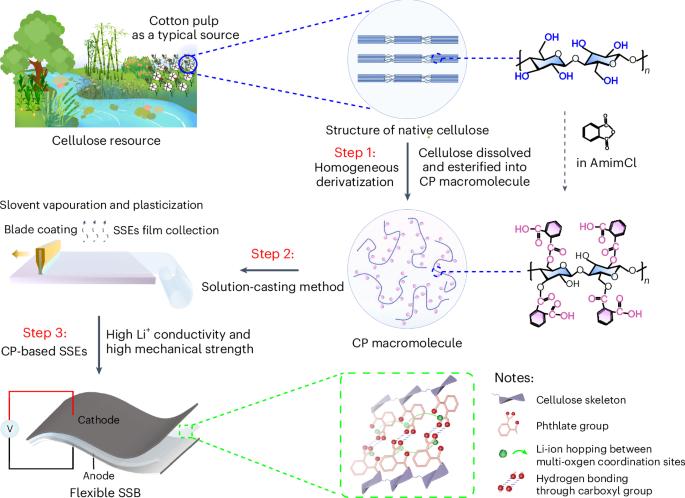用于固态电池电解质的可再生纤维素生物聚合物的分子工程学研究
IF 27.1
1区 环境科学与生态学
Q1 ENVIRONMENTAL SCIENCES
引用次数: 0
摘要
作为最丰富的可再生生物聚合物,纤维素已被广泛应用于医疗保健、包装、电子和环境修复等领域,为实现可持续发展做出了贡献。在这里,我们采用了一种绿色、可扩展的工艺,将纤维素转化为一种坚固的电解质,其锂(Li)离子电导率为 1.09 × 10-3 S cm-1,转移数为 0.81,机械强度为 12 兆帕。我们的工艺利用了纤维素中丰富的羟基,这些羟基通过酯化反应被邻苯二甲酸酐取代,形成邻苯二甲酸纤维素(CP)。实验和理论综合分析表明,引入邻苯二甲酸酯基团不仅对确保锂离子与多氧的有效相互作用以建立快速离子传输通道至关重要,而且还有利于分子间氢键的形成,从而产生令人印象深刻的机械性能。CP 生物聚合物薄膜甚至与大多数商用阴极材料兼容,与使用易燃有机液体电解质的基准锂离子电池相比,我们的固态 Li/CP/LiFePO4 电池在 1000 次循环中表现出更好的性能和显著的稳定性。我们的研究揭示了纤维素在电池中应用的巨大潜力,并为开发丰富且可持续的固态电解质开辟了一条途径。纤维素是自然界最丰富的可再生生物聚合物资源。在这里,作者通过分子工程将纤维素转化为电解质,在固态锂离子电池中显示出良好的性能。本文章由计算机程序翻译,如有差异,请以英文原文为准。

Molecular engineering of renewable cellulose biopolymers for solid-state battery electrolytes
As the most abundant and renewable biopolymer, cellulose has found applications in a range of fields such as healthcare, packaging, electronics and environmental remediation, contributing to the transition towards sustainability. Here we apply a green and scalable process transforming cellulose to a robust electrolyte exhibiting lithium (Li) ion conductivity of 1.09 × 10−3 S cm−1 with a transference number of 0.81 and mechanical strength of 12 MPa. Our process takes advantage of the rich hydroxyl groups in the cellulose which are replaced by phthalic anhydride through an esterification reaction to form cellulose phthalate (CP). Combined experimental and theoretical analyses reveal that the introduction of phthalate groups is essential to not only ensure effective multi-oxygen interaction with Li ions to create fast ion transportation channels, but also facilitates the intermolecular hydrogen bond responsible for the impressive mechanical properties. The CP biopolymer film is even compatible with most commercial cathode materials, and our solid-state Li/CP/LiFePO4 cells show better performance and notably good stability over 1,000 cycles than that of a baseline Li-ion cell with a flammable organic liquid electrolyte. Our study unlocks the enormous potential of cellulose utilization in batteries and opens an avenue for the development of abundant and sustainable solid-state electrolytes. Cellulose is the most abundant renewable biopolymer resource in nature. Here the authors convert cellulose to an electrolyte through molecular engineering showing good performance in solid-state Li-ion batteries.
求助全文
通过发布文献求助,成功后即可免费获取论文全文。
去求助
来源期刊

Nature Sustainability
Energy-Renewable Energy, Sustainability and the Environment
CiteScore
41.90
自引率
1.10%
发文量
159
期刊介绍:
Nature Sustainability aims to facilitate cross-disciplinary dialogues and bring together research fields that contribute to understanding how we organize our lives in a finite world and the impacts of our actions.
Nature Sustainability will not only publish fundamental research but also significant investigations into policies and solutions for ensuring human well-being now and in the future.Its ultimate goal is to address the greatest challenges of our time.
 求助内容:
求助内容: 应助结果提醒方式:
应助结果提醒方式:


